Collecting Telegraph Company Paper
by Ray Klingensmith
Reprinted from "INSULATORS - Crown Jewels of the Wire", July 1984, page 7
Have you ever wondered what
happened to all the old documents, maps, periodicals, telegrams and other paper
items associated with the "telegraph age"? Well, some of that material
has survived thru the decades and is actively sought by serious collectors. With
the ever growing interest in "go withs" in the insulator hobby, some
collectors have branched out to collecting related paper items. There are
numerous areas in this field, ranging from financial material including stocks
and bonds, message forms from various companies, the envelopes or
"covers" messages were delivered in, franks -- complimentary passes or
stamps used by individuals for free or half rate messages, and a wide variety of
other items. These items can create a great deal of interest in the history of
the companies that used them initially, and a collector can enjoy the challenge
of trying to obtain the early and more elusive material. It's a great hobby! Why
don't you join in on the fun?
I personally have been collecting "telegraph
paper" for a few years and have found it quite fascinating. There is just
enough difficulty in obtaining nice material to make it challenging, and yet
there is a very wide variety of items to be found. The more you get involved,
the more places you realize these collectible items can be found. Many of the
financial pieces are beautifully illustrated with scenes, figures and very
ornate artwork. This includes stock certificates and bonds. With so many items
to be collected and so much to be said about them, I'll just go into detail this
month on the stocks and bonds.
When the first telegraph companies were formed in
the 1840's, a great need for capital was created to construct and maintain the
lines. At first, telegraph promoters had a difficult time convincing the public
that the new invention would become a great success and ultimately change the
every day life of all humans. When those early companies were formed, many of
them issued stock to raise the needed funds. A stockholder normally received a
"stock certificate", a legal document stating his ownership of a
certain number of "shares" in the company. As an example, a company
might be formed with a capital of $50,000. The figure would be divided into 1000
shares of $50 each. A stockholder would be given a certificate showing the
number of shares he owned. In this case, if he purchased $5,000 worth of stock,
he would own 100 shares. Although most of them have been cancelled and are no
longer negotiable, those stock certificates of early days have become a very
collectible item.
The collecting of stocks and bonds has become a very popular
pastime, especially in the last four or five years. There are now thousands of
collectors in the United States, with an even greater interest in Europe.
Although railroad, mining and oil are the categories with the most interest,
communications certificates are also popular.
As mentioned earlier, the
telegraph industry played a very important role in changing the nation. The
growth of the East, taming of the West, communications during the Civil War and
countless other important events are a part of the history involved with these
documents. Also of interest are the signatures of many famous individuals who
were either company officials, or had the stock issued to them. Included among
these people are the Rockefellers, Jay Gould and many others. The value of some
certificates has risen to over $1000 each, if they have the signature of a
famous person. Most of those signatures appear on railroad and oil certificates,
but once in a great while the signature of a more famous person will also appear
on a telegraph certificate. In the earlier years, Samuel Morse many times
received shares of stock in a particular company as payment for use of his
patent. Therefore, some of the certificates issued to him would have his
signature on them from the time he sold the stock.
The value of many
certificates has increased dramatically over the past few years. Key factors
involved in determining value are age, signatures, ornateness, use of nice
illustrations, condition, and (most of all) supply and demand. Many times it is
difficult to judge at first how many of a particular type certificate have been
found. Sometimes an individual will hoard them for several years, trying to keep
the price up on them. As can be seen in the following examples, each certificate
was numbered consecutively from one thru how ever many were issued. A low issue
(less than 100) would have greater collector appeal than if tens of thousands
had been issued. If the certificates are four or five digits, it stands to
reason that there could be a large number of them available. Prices generally
range from $1 for the more recent AT&T and Western Union, to $150 for some
of the rarer, earlier types. There are a lot of types in the $5 to $15 range.
Well illustrated, pre 1880 scarcer types generally run between $50 and $125.
Rather than go into too much more detail at this time, perhaps it would be best
just to have a look at a few of the more interesting types. If you have more
questions concerning these historical and beautiful documents, please feel free
to contact me. I'd very much like to hear from you should you have any in your
collection. I might also add that I have duplicates of the New Orleans &
Ohio, and several others, should collectors be interested.
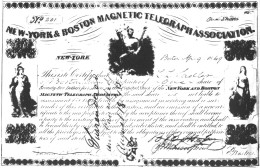
Medium Image (75 Kb)
Large Image (199 Kb)
Fig. 1. (This and the
following examples have all been reduced at least 50%.)
This certificate, dated
April 9, 1849, is the earliest I have seen yet. This company was drawn up in
1845, one of the earliest in the country. It was to be built with two wires,
following the Harlem Railroad to the outskirts of New York City, where it was to
turn eastward along the Turnpike through Stamford, Norwalk and Bridgeport to New
Haven, from which point it followed the right of way of the Hartford & New
Haven, the Worcester, and the Western Railroads to Boston. Notice the signature
of Francis 0. J. Smith, a very famous and controversial figure of the early
telegraph industry.
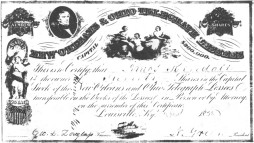
Medium Image (57 Kb)
Large Image (149 Kb)
Fig. 2.
This certificate is well illustrated and holds much
history. I believe the man pictured at left is Samuel Morse. This company was
also one of the very early lines in this country. This particular certificate is
issued to Amos Kendall, who was a partner of Samuel Morse. Norvin Green (who
later became president of Western Union) and George Douglass, whose signatures
appear as company officers, were both involved with the telegraph lines in the
south during the Civil War.
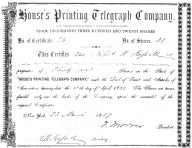
Medium Image (38 Kb)
Large Image (101 Kb)
Figure 3
This is a very rare
certificate from House's Printing Telegraph Company. This company was formed to
create a direct competition to the Morse lines. Due to the fact that there were
only eight shareholders when this company was formed, one could assume that a
very low number of certificates of this type were ever issued.
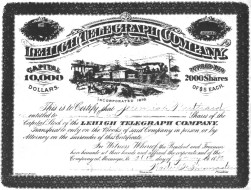
Medium Image (79 Kb)
Large Image (218 Kb)
Figure 4
This is a stock certificate of the Lehigh Telegraph Company. Although I have no
history on this particular company, this is one of my favorite certificates. It
has a beautiful border, and a great illustration of the railroad and telegraph
in use together. As far as I know, this is the only remaining example of this
certificate.
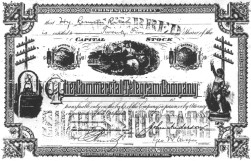
Medium Image (78 Kb)
Large Image (216 Kb)
Fig. 5.
Commercial Telegram Company stock certificate (David Beach
collection). Another superbly illustrated certificate. The printing telegraph
apparatus and telegraph poles make this a highly desirable certificate. The
poles, complete with insulators, are a design with great appeal to insulator
collectors. I have seen this design on at least two other types of certificates.
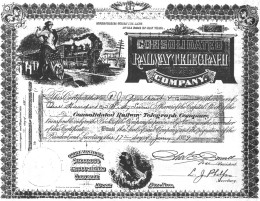
Medium Image (103 Kb)
Large Image (307 Kb)
Figure 6
This shows a capital stock certificate from the
Consolidated Railway Telegraph Company (David Beach collection). Another great
certificate making use of a well illustrated locomotive. This type of document
with fancy border, lettering, and detailed illustrations is much sought after by
serious collectors today.
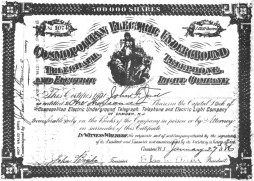
Medium Image (83 Kb)
Large Image (224 Kb)
Fig. 7.
This company is a combination of different
utilities, consisting of Telegraph, Telephone and Electric Light. The
illustrations on most of these certificates usually carry a great deal of
symbolism, making use of gods, goddesses, telegraph apparatus, etc.
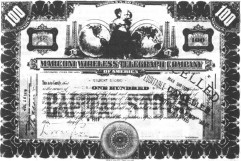
Medium Image (72 Kb)
Large Image (204 Kb)
Fig. 8.
The
famous Marconi Wireless Telegraph is represented here with a very ornate
certificate. These are among the most ornate of all types of stock certificates
and come in several different colors. The blue is of the more common type,
selling for $5 to $8, the purple being very rare.
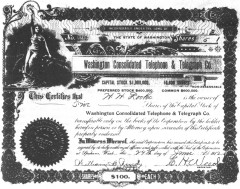
Medium Image (80 Kb)
Large Image (228 Kb)
Fig. 9
This shows a capital stock certificate of the Washington Consolidated Telephone &
Telegraph Co. Around the turn of the century a large number of companies were
formed with a combined name of "Telephone and Telegraph". This
particular company chose to have their name printed on a "Goes"
certificate. Goes was a printer who was very popular at the time, making use of
a number of similar borders and designs. They simply changed the printing plate
which contained the telegraph company name for each of their customers.
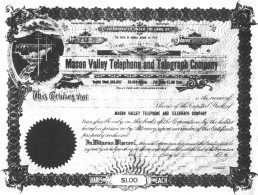
Medium Image (89 Kb)
Large Image (261 Kb)
Fig.
10.
Mason Valley Telephone and Telephone Company. Another of the small companies
which made use of a Goes printed certificate. Notice the similarity of the
border and printing of this one and figure 9. This one also has an interesting
illustration of a pole line and waterfalls.
| 